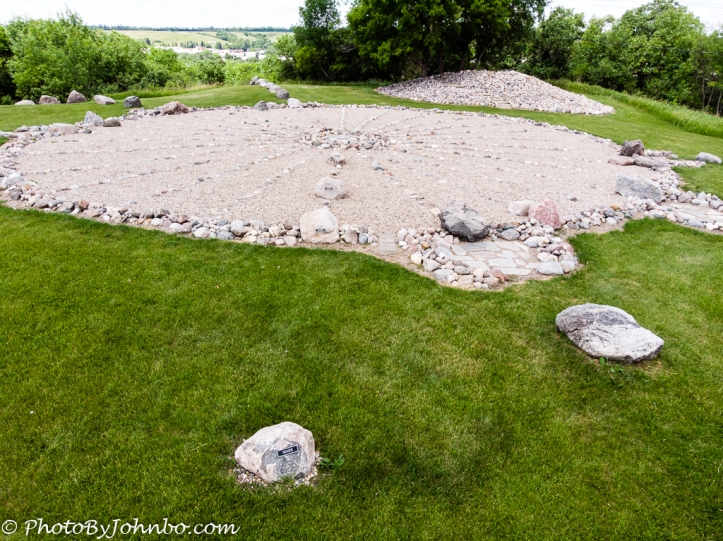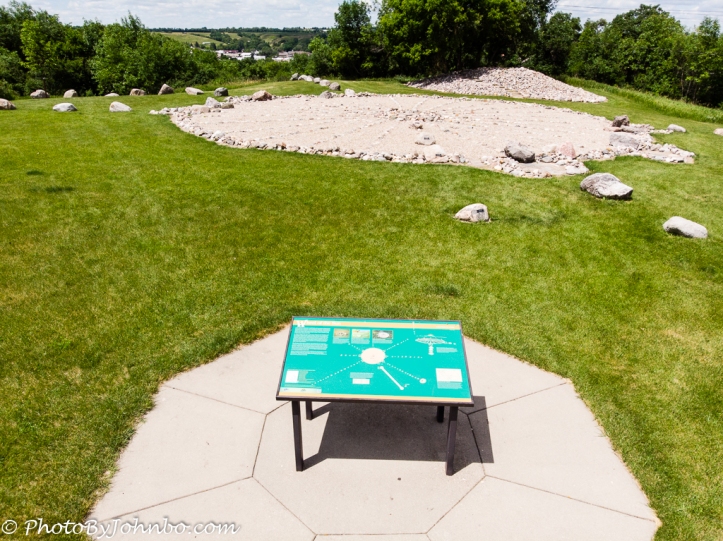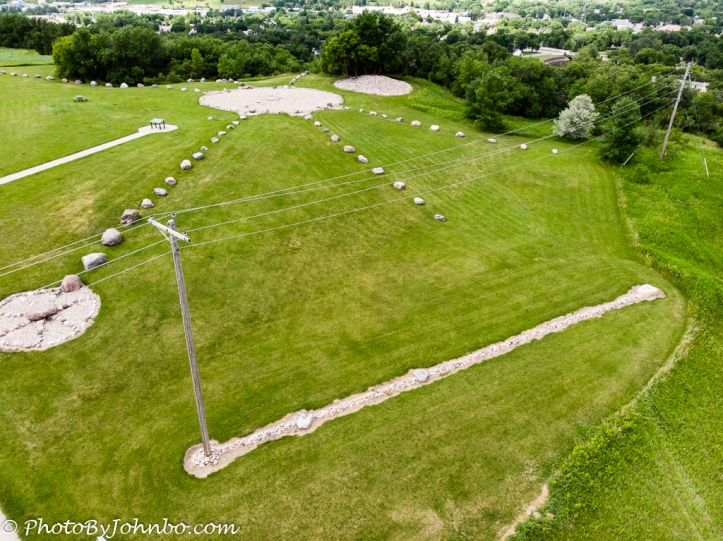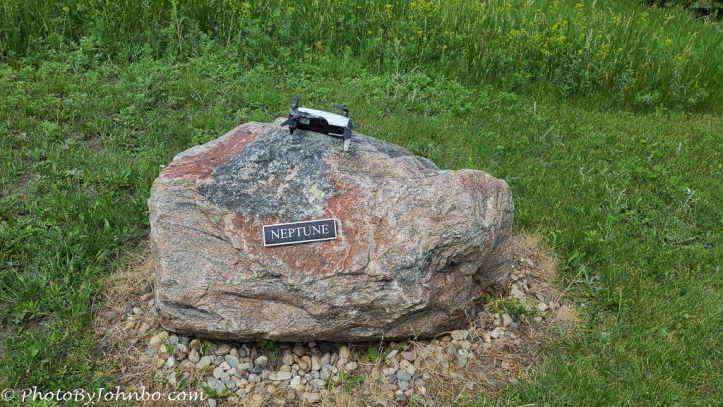On the campus of Valley City State University, a class project has grown into a 30-acre park and educational destination. The Medicine Wheel is visible from my drone shot in the top of the image above. The wheel is a basic solar calendar that uses the alignment of the sun to the spokes of the wheel to determine sunrise and sunset during each of the four seasons. The center of the medicine wheel is the sun in a solar system model. A short walk will take you by each of the nine planets (including our dwarf planet, Pluto) in the solar system.
An electrical utility line traverses the park near the medicine wheel. One of the poles was adopted to be a solar reference to the beginning of each season at local noon. That’s the scale in rocks laid out and extending away from the base of the pole. On the day of our trip, by the time we got to Valley City, (about an hour drive from our home in Fargo), an overcast sky moved in and obscured the shadow that would help in understanding the purpose of the pole.
 The most interesting feature in the park to me is the scale representation of our solar system. A trail, about a third of a mile (0.5 km), winds through the park. It’s an improved trail (ok, it’s a sidewalk most of the way.) The drone shot above focuses on the first four planets nearest the sun at the center of the wheel. Just below the sun is Mercury, the next larger rock is Venus, then Earth, and that boulder in the lower right is Mars. There is logic to the placement of each planet. This solar system model is built to scale with one foot (0.3 m) equalling three million miles (4.828 million km). The distance between the sun and that Mars rock is 47.2 feet (14.39 m) from the center of the wheel representing the planet’s distance of 141.6 million miles (227.9 million km) from the sun.
The most interesting feature in the park to me is the scale representation of our solar system. A trail, about a third of a mile (0.5 km), winds through the park. It’s an improved trail (ok, it’s a sidewalk most of the way.) The drone shot above focuses on the first four planets nearest the sun at the center of the wheel. Just below the sun is Mercury, the next larger rock is Venus, then Earth, and that boulder in the lower right is Mars. There is logic to the placement of each planet. This solar system model is built to scale with one foot (0.3 m) equalling three million miles (4.828 million km). The distance between the sun and that Mars rock is 47.2 feet (14.39 m) from the center of the wheel representing the planet’s distance of 141.6 million miles (227.9 million km) from the sun.
 Five informational placards describe the features and educational functions of the park. The park also contains twelve mounds (one of which is behind the medicine wheel in the photo above.) These mounds date back five to twelve centuries and contain the remains of Plains Woodlands Indians.
Five informational placards describe the features and educational functions of the park. The park also contains twelve mounds (one of which is behind the medicine wheel in the photo above.) These mounds date back five to twelve centuries and contain the remains of Plains Woodlands Indians.
The park also features a segment of the North Country National Scenic Trail (NCT). This footpath stretches over 4,600 miles (7,400 km) from Lake Sakakawea State Park in central North Dakota to Middlebury in central Vermont. It connects both the Long Trail (and Appalachian Trail) with the Lewis and Clark Trail. This trail traversing eight states is about 75 percent complete as of 2019. More about the trail can be found on Wikipedia here.
As we walked along the path, I snapped images of the remaining planets for the gallery. Note that the boulder representing Saturn even has an iron “frame” representing those rings. After you reach Neptune on your multi-million-mile simulated journey, you can leave the park, walk through a strip mall parking area, walk some more, and you will discover the demoted planet, Pluto. You’ll note it missing from the gallery as we decided to move on.
To give you a size reference to these boulders, I put my Mavic Air drone on top of Neptune and captured a cell phone photo. Of course, after our trip, I posted this photo on Facebook and captioned it with, “I flew my drone today. Landed it on Neptune. Eat your heart out, Elon Musk.”
John Steiner








I love your last comment. I recently saw one of these solar system layouts but can’t recall where I was. It’s pretty cool to get a sense of the distance even at scale.
I hadn’t heard of one of these parks before. I started following a site called Only in (your state), and they clued me in on the park that is only about an hour’s drive from our house.
I get Only in Your State for NH. It’s shown me some real gems.
Excellent post that makes me want to visit this park some day. In the winter, would it be covered with deep snow? In the warmer seasons, wouldn’t it be a pain to mow the grass around all these sun and planets?
The park would indeed be covered in snow, though being on a hill, it might be more accessible than one would think. I’m sure there is a lot of string trimming being done to keep the planets looking their best.
Most interesting John, and congratulations on being the first to land a drone on Neptune!
Fabuleux!
This is so cool, John, thanks for sharing this with me. I had to LOL when I saw the pic of the drone parked on Neptune and your comment! The teacher at the school told me that last year, the kids made much smaller rocks and they all got stolen–perhaps the community felt they were available as mementos! These will be harder to walk away with.
Too bad the rocks were stolen. Making the planets from boulders does make that job a lot harder. Of course, the kids would have needed a skid steer loader to place them. >grin<
True! This year’s rocks are still small enough to take but perhaps the random trail hikers will leave them be once they know what they signify. We shall see!